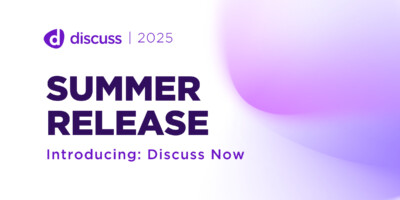4 Reasons to Use Pre-Work to Optimize Live Conversations

We all know the feeling: short on time and needing to hold multiple qualitative sessions under deadline, we rush from one conversation to the next, and there never seems to be enough time to dig deeper to gain rich insights.
Yet there are plenty of ways to gain more insights, even without the need to set up more live sessions. Gaining unmoderated customer feedback through Pre-Work with Discuss can unlock even more context about respondents and make the most out of the conversations you have.
Think of your qualitative study as a painting you’re about to create, and Pre-Work as a way to begin a sketch. Wouldn’t it be wise to sketch out a framework before starting to paint?

Below are four reasons to leverage Pre-Work ahead of moderated customer conversations:
- Give respondents more time for critical thought. Design your project to give respondents the time they need to consider the key themes and questions you would like to explore through your study. When you allow people to submit responses on their own time, you’ll move your live conversation’s starting point from the general to the more specific even faster, gaining richer feedback along the way.
- Get to know your respondents better. You understand that a live conversation will allow you to hear thoughts, opinions, and emotions from customers, but do you have all the context you need to understand why they may be giving you those responses? Spend less time asking background questions in a live session by getting key details ahead of time. You can also ‘break the ice’ with focus group respondents through Pre-Work questions.
- Engage with stimuli earlier. Why spend time on the process of sharing stimuli live, when you could share it ahead of a discussion? Here are just a few examples of stimuli to before a live session:
— For quick comparison feedback: Share a piece of advertising stimuli and ask for a text response on which ad they prefer. Explore the reasons why your respondent made their choice in a live session.
— For traditional homework: Share a document for them to fill out as stimuli, such as a survey, a grid with emotions for them to mark, etc. Explore any themes that might come up in a live session. l
— To create stimuli for use in a live session: For in-home usage testing, you can prompt respondents to share how they use a product. In the case of a household cleaning product, for example, you can ask them to show you how they use the product through pictures. Use their pictures as stimuli in a live session. - Get respondents’ temperature check ahead of a session. For attitudinal analysis, you can use video-based responses in Pre-Work to gauge respondents’ feelings, emotions, or responses to ongoing events of the day. This will give you more contextual insights as to how and why they may respond to your questions in a live conversation.
Pre-Work Best Practices
- Allow plenty of time. Don’t wait until the last minute and give unrealistic deadlines; it’s critical that respondents are given ample time for project completion. Before giving them the work, it’s also a good idea to understand how long their response will take and clearly indicate the project estimate time when making an appeal.
- Be transparent. Start with a simple explanation of the purpose of the assignment, and let them know how the work that you’re asking them to do will be used to pre-empt any concerns. This will increase the likelihood that they will participate.
- Give clear instructions. Any directives should be short, easily digestible and easy to submit. Imagine that most of your prospective respondents are seeing your directions on mobile, as they most likely are, and write concise instructions that are direct and to the point.
- Get creative with tasks. Give respondents engaging tasks to complete on their own. Ask for photos, videos, share stimuli, give them a document activity to re-upload, the possibilities are endless.
- Monitor completions and keep engaged. You can’t assume that every person is going to complete a pre-work assignment on time, or that your initial invitation will even be read. That’s why it’s important to monitor responses to attract enough participants. Many project managers over-recruit by 10-15% to allow for people who are not engaged.
- Get the right platform. Setting up different task types (ie. video, photos, text, documents, etc.), tracking those tasks, and bringing the results into a live discussion as stimuli should be easy. With the right platform, you can send pre-work and manage the results from one central hub without the friction of managing multiple tools and online platforms.
See how to bring context and color to customer responses with pre-work, unmoderated customer feedback and moderated live sessions to drive better insights and outcomes by learning more about the Discuss People Experience Platform.
Ready to unlock human-centric market insights?
Related Articles

Enhance Customer Interactions Using Cutting-Edge Customer Experience Software
CX software, bursting with various tools and bolstered by careful market research, marks the hallmark for enhancing customer interactions. It…
CX software, bursting with various tools and bolstered by careful market research, marks the hallmark for enhancing customer interactions. It…

3 Ways to Combine Communities with Live Video Qualitative
There is no better combination than peanut butter and chocolate. Salty and sweet join to give you the best of…
There is no better combination than peanut butter and chocolate. Salty and sweet join to give you the best of…

Leveraging Discuss to Harness the Power of Customer Insights
“People don’t buy what you do; they buy why you do it.” ― Simon Sinek, Start with Why: How Great…
“People don’t buy what you do; they buy why you do it.” ― Simon Sinek, Start with Why: How Great…



